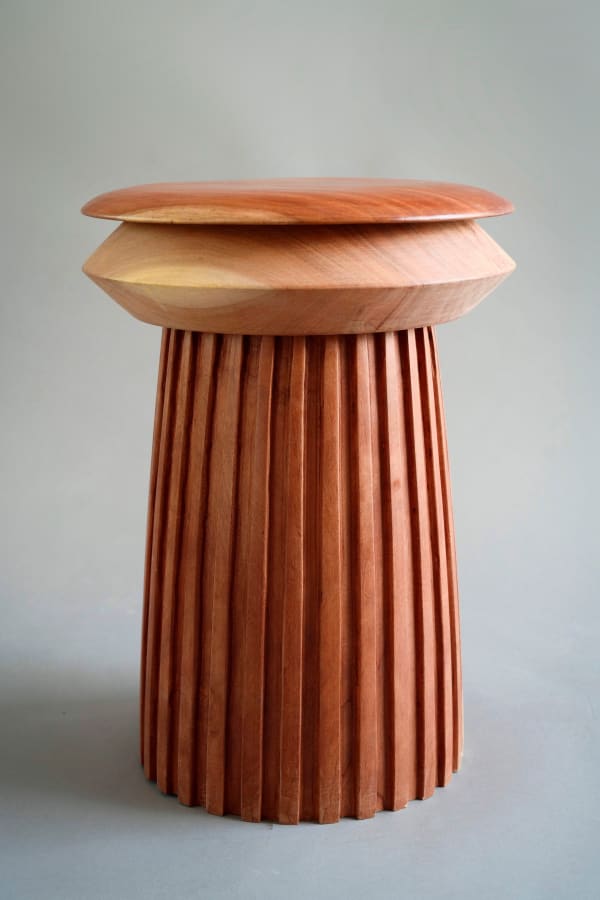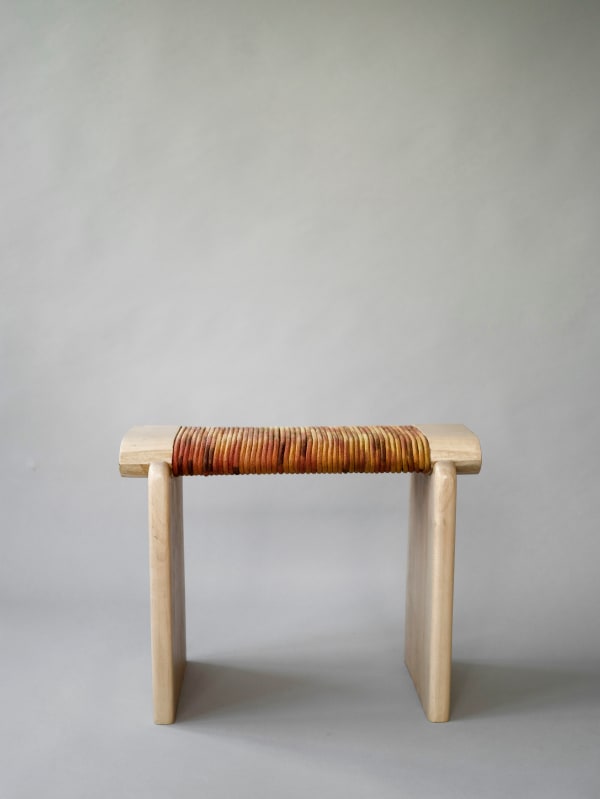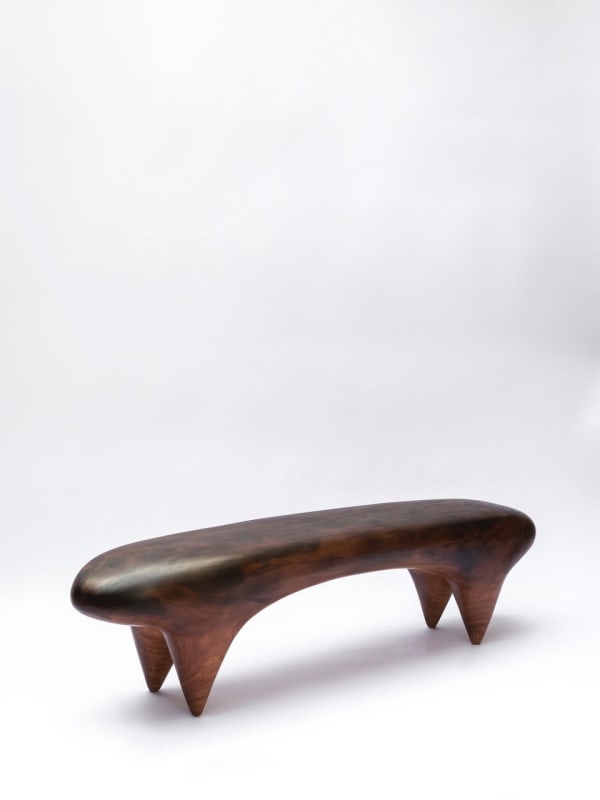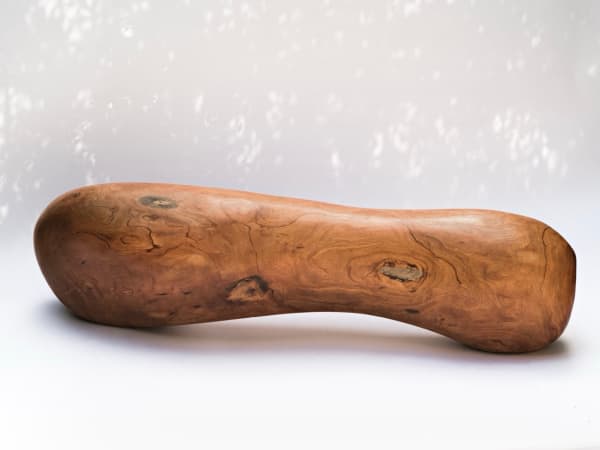-
Presentation
Galerie Maria Wettergren is proud to present Estelle Yomeda first solo exhibition in France, Animal Vegetal, from November 6, 2025, to January 17, 2026.
Estelle Yomeda's artistic process is based on discoveries of ancestral knowledge and human encounters with craft people. This ethic feeds her creativity and leads her to launch, in 2018, her design studio Kente Project, through which she creates limited editions and unique works. Its name comes from its discovery of Kente, a traditional weaving that has spanned the centuries to establish itself as the identity and symbolic fabric of Togo and Ghana.
Fully handmade, Yomeda's signature works are sculptural furniture pieces, made of solid Togolese wood of an extraordinary beauty, characterized by their tactile quality and sensual silhouettes, reflecting the expertise of Togolese craftspeople. Highly organic, Yomeda's sculptural furniture pieces appear loaded with life and animistic presence. Yomeda's use of local Togolese wood species, such as Mélina, Neem or Cassia, are chosen for their sustainability, offering her tactile works a natural warm polychromy. Setting out to meet the artisans of Lomé, Estelle Yomeda is exploring the crossing of knowledge and intercultural exchanges, interweaving trans-generational memories and ancestral techniques, to transform pieces of furniture into contemporary relics.
-
Works
-

Estelle Yomeda
Ekko II, 2021Melina wood, Cassia Simea wood
Ø 34 x 45 cm
Limited edition of 20 -

Estelle Yomeda
Sokode, 2023Waxed Ceylon Mahogany (Neem wood),
marine lacquer finish
Ø 40 x 45 cm
Limited edition of 8 + 4 AP -

Estelle Yomeda
Nou Oulanou I, 2024Waxed Ceylon Mahogany (Neem wood)
Ø 33 x 46 cm
Limited edition of 8 + 4 AP -

Estelle Yomeda
Nou Oulanou II, 2024Waxed Ceylon Mahogany (Neem wood), burnt and waxed Ceylon Mahogany (Neem wood)
Ø 32 x 47 cm
Limited edition of 8 + 4 AP -

Estelle Yomeda
Zo, 2025Neem wood (Azadirachta indica)
ca. 35 x 130 x 30 cm
Unique piece -

Estelle Yomeda
Miroir Bestiole II, 2025Prosopis wood
26 x 25 x 9 cm
Limited edition -

Estelle Yomeda
Miroir Véyi, 2025Prosopis wood
28 x 22 x 9 cm
Limited edition -

Estelle Yomeda
Assigamé S (Orange), 2023Melina wood, cotton cordage
Hand sculpted, hand dyed
43 x 56 x 34 cm
Limited edition of 8 unique pieces -

Estelle Yomeda
Assigamé S (Green), 2023Melina wood, cotton cordage
Hand sculpted, hand dyed
46 x 56 x 34 cm
Limited edition of 8 unique pieces -

Estelle Yomeda
Zo, 2025Hand-sculpted, flame-finished, walnut-stained
40 x 160 x 35 cm
Limited edition of 8 unique pieces -

Estelle Yomeda
Assigamé S, 2023Cassia wood, cotton cordage
Hand sculpted, hand dyed
44.5 x 56 x 34 cm
Limited edition of 8 unique pieces -

Estelle Yomeda
Assigamé M, 2025Royal lingué wood, cotton cordage
Hand sculpted, hand dyed
49 x 80 x 34 cm
Limited edition of 8 unique pieces -

Estelle Yomeda
Assigamé XL, 2025Royal lingué wood, cotton cordage
Hand sculpted, hand dyed
ca. 49 x 120 x 35 cm
Limited edition of 8 unique pieces -

Estelle Yomeda
Afa, 2025Neem wood
Hand sculpted, waxed
ca. 44 x 160 x 47 cm
Unique piece -

Estelle Yomeda
Sokodé, 2023Neem wood
Hand turned, hand sculpted, flame finished, waxed
Ø 40 x 40 cm
Limited edition of 8 unique pieces -

Estelle Yomeda
Miroir Rhizome I, 2025African beads and antique beads, shells, plant fibers on brass
rods, mirror, leather covered wooden frame
Ca. 60 x 35 x 20 cm
Unique piece -

Estelle Yomeda
Miroir Rhizome II, 2025African beads and antique beads, shells, plant fibers on brass
rods, mirror, leather covered wooden frame
Ca. 43 x 33 x 16 cm
Unique piece
-
-

-

-
-
Digital Catalogue
ESTELLE YOMEDA: Animal Vegetal
Current exhibition
































